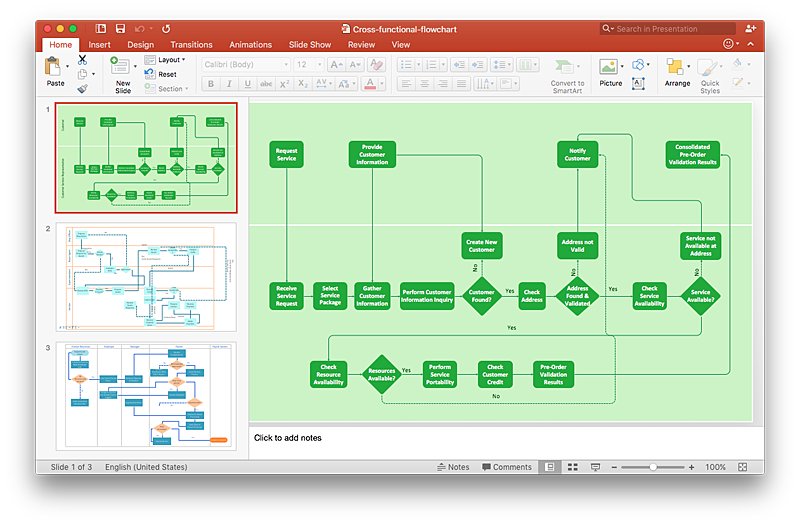HelpDesk
How to Add a Cross-Functional Flowchart to a PowerPoint Presentation Using ConceptDraw PRO
Using a Cross-Functional flowchart is a clear way of showing how business processes get shared or transferred between different teams and departments. ConceptDraw PRO allows you to make an MS PowerPoint Presentation from your flowcharts in a few simple steps."In elementary algebra, a quadratic equation (from the Latin quadratus for "square") is any equation having the form
ax^2+bx+c=0
where x represents an unknown, and a, b, and c are constants with a not equal to 0. If a = 0, then the equation is linear, not quadratic. The constants a, b, and c are called, respectively, the quadratic coefficient, the linear coefficient and the constant or free term.
Because the quadratic equation involves only one unknown, it is called "univariate". The quadratic equation only contains powers of x that are non-negative integers, and therefore it is a polynomial equation, and in particular it is a second degree polynomial equation since the greatest power is two.
Quadratic equations can be solved by a process known in American English as factoring and in other varieties of English as factorising, by completing the square, by using the quadratic formula, or by graphing." [Quadratic equation. Wikipedia]
The flowchart example "Solving quadratic equation algorithm" was created using the ConceptDraw PRO diagramming and vector drawing software extended with the Mathematics solution from the Science and Education area of ConceptDraw Solution Park.
ax^2+bx+c=0
where x represents an unknown, and a, b, and c are constants with a not equal to 0. If a = 0, then the equation is linear, not quadratic. The constants a, b, and c are called, respectively, the quadratic coefficient, the linear coefficient and the constant or free term.
Because the quadratic equation involves only one unknown, it is called "univariate". The quadratic equation only contains powers of x that are non-negative integers, and therefore it is a polynomial equation, and in particular it is a second degree polynomial equation since the greatest power is two.
Quadratic equations can be solved by a process known in American English as factoring and in other varieties of English as factorising, by completing the square, by using the quadratic formula, or by graphing." [Quadratic equation. Wikipedia]
The flowchart example "Solving quadratic equation algorithm" was created using the ConceptDraw PRO diagramming and vector drawing software extended with the Mathematics solution from the Science and Education area of ConceptDraw Solution Park.
- Algorithm Power Function Flow Chart
- Flow Chart Using Pow Function
- Flowchart Pow Function
- Flow Chart For Power Functions
- Draw Flowchart Pow Function
- Algorithms And Flowcharts To Solve Functions
- Draw A Flowchart Using Pow Function
- Flowchart About Algebraic Function
- Process Flowchart | Draw A Flow Chart To Compute A Raise Power ...
- Functions Of Algorithm And Flow Chart
- Functions Of Algorithm And Flowchart
- How To Make A Flowchart Quadratic Function
- Types of Flowcharts | Process Flowchart | Business Process ...
- Function hall floor plan | Basic Flowchart Symbols and Meaning ...
- Solving quadratic equation algorithm - Flowchart | Basic Flowchart ...
- Diagram Or Chart About Quadratic Function
- Algorithm And Flowchart Their Functions And Characteristics
- Draw The Flow Chart Of An Algorithm Of Quadrant Function
- Types of Flowcharts | Process Flowchart | Business Process ...

